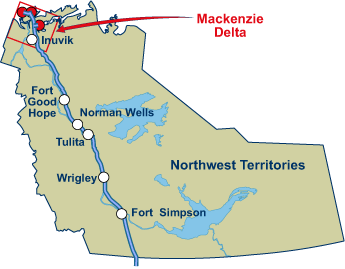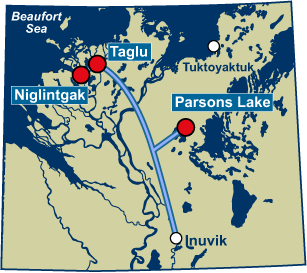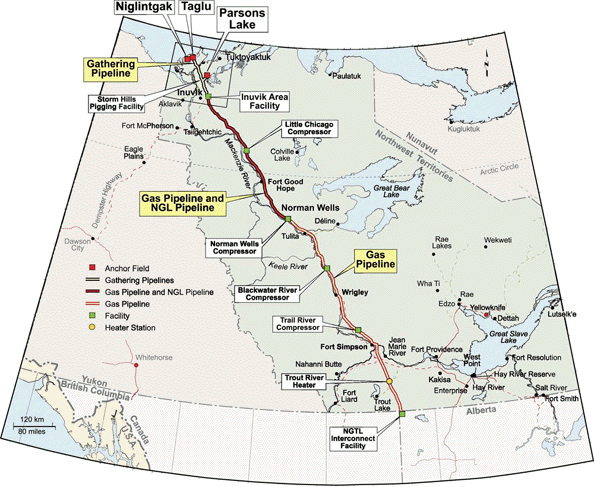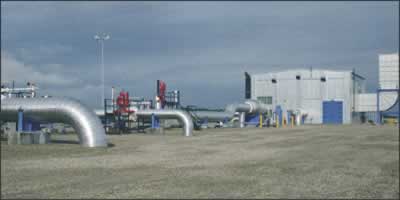 Click to Enlarge
Click to Enlarge
Although gas prices have since fallen and interest rates have risen, there remains an understanding that the gas market is destined to become progressively tighter in the future as existing gas supplies dwindle in the face of strong demand on both sides of the border. Interest in building a pipeline to bring Mackenzie gas south remains strong, although construction cost estimates have increased substantially, even over the last couple of years. As the federal government gets closer to reaching agreements with the First Nations involved, the last hurdle to construction may soon fall. For First Nations communities, however, the deal may just tie them even more tightly to an unsustainable fossil fuel dependency at the peak of the petroleum age.
The History of the Pipeline – the Berger Commission
The Mackenzie River – or Deh Cho, meaning Big River – flows 1,730 kilometers north from Great Slave Lake in the North West Territories to Arctic Ocean, where it forms an extensive delta. The river, an important transportation route to the western arctic, is a lifeline for several different cultural groups. The Dene are an aboriginal nation living along the river valley, the Inuvialuit – descended from Inuit and European parents – reside along the mainland Arctic coast, the Inuit primarily populate the arctic islands, the Metis are of mixed First Nations and European heritage, and there are also populations of non-native Canadians. The population density is very low.
A Mackenzie Valley pipeline was first proposed in the 1970s, after the discovery of gas fields in the Mackenzie delta. At the time it was billed as the biggest project in the history of free enterprise. A federal royal commission, under Thomas Berger, was appointed in 1974 to consider the proposal and their socio-economic impact on the North. The timing of the inquiry coincided with an era of native activism instigated by the government’s 1969 proposal to abolish treaty rights and native reserves, withdrawn after a storm of protest. The commission held hearing across the north in 1975/76 and in 1977 issued a report recommending the pipeline project be delayed at least ten years – until native land claims could be settled. Berger warned that the infrastructure supporting a northern energy corridor would be enormous and the impact on the inhabitants of the region and its environment would be very significant.
At the time, native leaders were staunchly opposed to the pipeline. For instance, Chief Frank T’Seleie accused oil company executives at the Berger commission hearings of planning to destroy a people with 30,000 years of history for the sake of a twenty year supply of gas. Thirty years later, T’Seleie and Stephen Kakfwi, another vehement former pipeline opponent subsequently elected Premier of the Northwest Territories, are strong backers of a Mackenzie Valley pipeline. The difference in stance is a reflection of a newfound capitalist spirit amongst many aboriginal leaders and their people. They originally saw the pipeline as an attempt by southern business interests to exploit the resource wealth of the north with little regard for the inhabitants. Now, however, they are included in the development process, where they have the opportunity to invest directly in pipelines and other associated businesses and to earn resource revenue.
Gas in the Arctic – the Three Anchor Fields
Canada’s north is estimated by the National Energy Board to contain some 153 tcf of natural gas, or one third of Canada’s remaining natural gas reserves. An estimated 64 tcf of these reserves, only 9 tcf of which has actually been discovered, lie in the Beaufort-Delta area that would be served by the Mackenzie Valley pipeline, although significant additional reserves are expected to be discovered along the pipeline route to the south of the Delta. The arctic islands of Nunavut are thought to contain 63 tcf, but an almost total lack of infrastructure may prevent those reserves from being developed.

Click to Enlarge
The three anchor fields for the Mackenzie Gas Project, all of which were discovered in the early 1970s, are Parsons Lake, Taglu and Niglintgak. Parsons Lake, estimated to contain 1.8 tcf of natural gas, is jointly owned (75%:25%) by ConocoPhillips and ExxonMobil, while Taglu, estimated to contain 3 tcf, is owned by Imperial and Niglintgak, estimated to contain 1 tcf, is owned by Shell. If the pipeline goes ahead, the four companies are expected to invest at least $2.2 billion developing these fields.
The initial amount of gas expected to be shipped from the three anchor fields along a Mackenzie Valley pipeline is approximately 0.8 bcf per day, but pipeline proponents expect this to increase significantly due to additional exploration and development in the area once a pipeline is actually built. The companies planning to construct the pipeline expect it to carry 1.2 bcf per day once additional production comes on stream. Without the pipeline, production in the Northwest territories seems set to continue declining. According to the department of Indian and Northern Affairs, production fell 68% between 2001-2005.
The Mackenzie Gas Project
The Mackenzie Gas Project is gargantuan in scale. Imperial Oil, which is to construct the pipeline if it is approved, has yet to release a new cost estimate, but it has been suggested that the cost could reach $10 billion. The project consists of five parts: three natural gas field production facilities, a gathering pipeline system, a gas processing facility near Inuvik, a natural gas liquids pipeline from the Inuvik area facility to Norman Wells and a natural gas pipeline from the Inuvik area facility to northwestern Alberta. The pipelines are to be constructed underground along most of the length of the Mackenzie River tunnelling under 500 rivers and streams. The main pipeline would cross four aboriginal regions in the Northwest Territories – the Inuvialuit Settlement Region, the Gwich’in Settlement Area, the Sahtu Settlement Area and the Deh Cho Territory. A short segment would be built in northwestern Alberta near the border with the Northwest Territories, where it could impact on Dene Tha land.

Click to Enlarge
Environmental Concerns
The Mackenzie Valley watershed covers almost a fifth of Canada – an area twice the size of Ontario. It is the largest in Canada and its northern reaches are virtually pristine. Environmentalists are extremely concerned about the impact a pipeline would have on the region. They point to fragmentation of wilderness, loss of biodiversity, increased greenhouse gas emissions, reduction of boreal carbon sequestration capacity, exposure of wildlife to hunters or predators and the potential for permafrost melting.

Although the temperature of the natural gas in the pipeline is to be controlled in order to minimise temperature effects on the permafrost and on the pipeline itself, the potential would still exist for pipeline damage due to frost heaving. This could lead to leaks of natural gas or natural gas liquids, which could case environmental damage and potentially explosions or fires. Given that the effects of climate change are expected to be more severe in the north than in other regions of Canada, the pipeline could end up embedded in watery soil rather than frozen ground.
Although 120-foot-wide right-of-way would be constructed during winter in order to minimise permafrost damage due to heavy equipment, the construction phase would still have very significant impacts on the environment. Construction staging areas, barge landings and camps for thousands of workers would be required, necessitating clear areas of clear-cutting. Increased sedimentation in the river could harm fish habitat.
Once a pipeline has been built, environmentalists are also concerned about the impact an increased level of exploration and development activity would have on the fragile environment of Northwest Territories.

The Current Review Process
The current review process is divided into two parts. The National Energy Board (NEB) has been examining the engineering design and economic feasibility of the project since early 2006, while the Joint Review Panel (JRP) has been conducting hearings into the environmental and social consequences of the project. The project requires support from the JRP and subsequent regulatory approval from the NEB. Imperial Oil, which would build the pipeline, would then make its decision as to whether or not to proceed based on economic factors.
The Joint Review Panel has extended its series of public meetings until April 2007, although the process may be complicated by a recent court ruling which could require the consultation process to be restarted. The court found that the Federal government had failed to consult with the Dene Tha First Nation of northern Alberta as to the impact of the pipeline on its territory near the terminus of the proposed pipeline. The judge ruled that the JRP could not file its report until another hearing made recommendations as to remedies for the 2,500 Dene Tha.
Pipeline Construction – Increased Costs and the Quest for Government Subsidies
The most recent cost estimate for the pipeline put the price at $7.5 billion in 2003 dollars. Although it has not yet released a new cost estimate, Imperial Oil has said there have since been significant upward cost pressures, particularly on labour and steel, which could have raised the cost to over $10 billion. In addition, natural gas prices recently fell from $12 per million btu to below $5 per million btu. Imperial has said it is concerned about the economics of the project under the present circumstances and has said it is seeking fiscal certainty from the Federal government in order to be confident about its expectations.
Imperial’s cost review, which was to have concluded by the end of 2006, will extend well into 2007. The company had been seeking $1.2 billion in federal tax benefits and other assistance when the project had been expected to cost $7.5 billion, but now federal officials are expecting a request in the $2 billion range. The government is, however, apparently reluctant to provide a major subsidy to Imperial given the profitability of major oil companies. With several provinces making requests of their own federal money to support energy projects, the government seems unlikely to add to the funds it has already set aside. These funds include $500 million to address socio-economic impacts on indigenous communities due to the planning and construction of the pipeline, $75 million to increase its own capacity to review the Mackenzie Gas Project and $21 million for the economic development of the Deh Cho First Nations and for their participation in the project review. However, in September a government representative said it would be willing to consider an equity stake in lieu of subsidies.
Alternatives North, a social alliance of churches, labour unions and environmental groups based in Yellowknife, has filed its own financial analysis of the project with the JRP which suggests that the pipeline would remain economically viable even with no government assistance. The report suggests that the project will yield a 22 per cent rate of return even if capital costs rise 30 per cent over previous estimates.
TransCanada Pipelines is positioning itself to take over the Mackenzie Valley project, should Imperial Oil declared the project uneconomic and walk away.
First Nations Land Claim Settlements and a New Way of Life
There have been a number of land claim agreements in the Northwest Territories since the days of the Berger Inquiry – the Inuvialuit in 1984, the Gwich’in in 1992, the Sahtu in 1994, and the Inuit in the Eastern Arctic through the creation of Nunavut in 1999. The agreements, in various stages of implementation and development, have resulted in aboriginal peoples gaining ownership of land and resources, and having control over resource development. They have ushered in a new way of life for the aboriginal people of the north.
I wish to speak briefly about the Inuvialuit who occupy the Delta, the western part of the Northwest Territories. Since their claim in 1984, they have successfully managed their lands and resources. They have used their monies in appropriate investments and business opportunities. Today, the Inuvialuit are a driving force in the Delta region and western NWT. They have spread their investment tentacles throughout Western Canada. They have invested in all kinds of projects and businesses. They own office buildings. They have an oil and gas exploration company, regional airlines, barging and trucking companies and a multitude of businesses which provide employment for their people and others. In June 1999, the Inuvialuit completed a 30-mile natural gas pipeline from a gas field on their lands to Inuvik which now provides fuel for heating and power production.I noticed in a recent magazine article that the Inuvialuit are offering some lands for oil and gas exploration through a bid process. In 1999, they signed $180 million worth of contracts for exploration work on their lands. The 1998 annual report of the Inuvialuit Regional Corporation, the latest report available, outlines the success of all the various corporations as being $8 million in profit.
The opportunity to join the modern economy has pleased many aboriginal people. They appreciate the chance to become more independent and self-reliant and resent the opposition to the Mackenzie Gas Project from environmentalists. However, many others feel that the project will destroy their traditional way of life and the cultural, social and environmental fabric that they rely on.
The Aboriginal Pipeline Group
The Aboriginal Pipeline Group (APG) was created in 2000 following meetings in Fort Liard and Fort Simpson. Thirty Aboriginal leaders from all regions of the Northwest Territories signed the resolution that created the APG and set its goals. The APG represents the interests of Aboriginal people in the Northwest Territories in maximising the ownership and benefits in a Mackenzie Valley natural gas pipeline.The message that the chiefs and the aboriginal leaders wish to make is that, yes, times have changed. Aboriginal peoples are no longer opposing projects, such as huge gas pipelines traversing their lands. However, they intend to be involved in all aspects of the project – the planning, the route selection, construction and, most important, ownership of the pipeline.
The APG, whose preliminary research costs have been funded through a loan from TransCanada Pipelines, has negotiated a deal by which its ownership of and revenues from the pipeline are to be determined by the amount of gas flowing through it. This does not initially amount to the one third share commonly quoted in the media. At the volume of gas initially expected to flow south – approximately 0.8 bcf per day – the deal would give the APG 3% ownership of the line. The stake would grow to 18% with an increase of 0.2 bcf per day, while an additional 0.4 bcf per day would take the aboriginal share to one third. The success of the deal from the perspective of the APG is therefore heavily dependent on additional exploration and development in the Northwest Territories. The APG is confident that this will occur, but if it does not, the APG could be left with large loans to repay and little means with which to repay them.
The APG will have to repay the TransCanada Pipelines loan, estimated at $140 million, once the regulatory review concludes. With approval of the pipeline and long-term shipping contracts, the APG would be able to borrow the $1.6 billion share of the pipeline construction cost that it would be responsible for. Once gas began to flow, the APG would receive its share of transportation fees, after the operating costs of the pipeline were covered. The APG expects to earn $10-$20 million per year above the cost of repaying the loan for the first twenty years, depending on the quantity of gas flowing. After repayment of the loans, the APG expects to earn up to $120 million per year. These returns are, however, contingent on a risky business prone to boom and bust, especially when energy prices are volatile.
In addition to returns from gas flowing south, the First Nations involved in the APG also expect to benefit considerably from economic development as a result of the pipeline. They anticipate up to 8,600 skilled and unskilled jobs during the construction period, as well as many business opportunities for supplying goods and services to pipeline construction crews and companies. New training programs have been initiated for aboriginal oil service workers in anticipation of these employment opportunities.
Currently, three of the four main aboriginal groups have signed on to the APG – Sahtu, the Gwich’in and the Inuvialuit. Of these, the Sahtu will have a 34% stake in the APG, the Gwich’in a 20% share, and the Inuvialuit a 4% share. The Deh Cho leadership, which would have been allocated a 34% stake, has declined to participate. The remaining 8% has been set aside for other aboriginal groups in the Northwest Territories.
The Deh Cho Holdouts
Grand Chief Herb Norwegian has consistently linked Deh Cho participation in the Mackenzie Gas Project to settlement of their outstanding land claim, which covers 40% of the planned pipeline route. The federal government has made an offer which it describes as “consistent with other agreements that the government of Canada has negotiated over the last 30 years North of 60”. The Deh Cho Dene were offered $104 million and ownership of about 18% of their traditional land, along with surface and mineral titles, but Norwegian called it a “low-ball” offer. Instead, the Deh Cho leadership is seeking a power-sharing agreement over 80,000 square miles of ancestral territory, allowing them to preserve lands for cultural or environmental reasons, to control industrial development and to collect royalties and taxes. However, the chief federal negotiator has refused to contemplate giving 4,500 people the power to govern an area about half the size of France.
Deh Cho leaders have acknowledged that withholding support for the project gives them leverage to secure unprecedented authority, but the federal government appears ready to call their bluff, indicating that they are prepared to authorise the project with or without Deh Cho approval. The Grand Chief has threatened in return to resort to litigation and blockades. Fred Carmichael, chairman of the APG, adding to the game of brinkmanship, has commented:
They are walking on pretty thin ice, because at the end of the day they could end up with no ownership in the pipeline and it could be built without any settlement of their land claim.
The unity of the Deh Cho appears to be crumbling under the pressure, with half the population rejecting the link between land claims talks and joining the APG. Separate Deh Cho groups are now seeking to join the APG in their own right and stand to receive a proportionate share of the 34% ownership reserved for the Deh Cho First Nation as a whole. This group, led by relatives of the Grand Chief, believes political negotiations shouldn’t prevent the Deh Cho Dene from doing business and taking advantage of what they see as an economic opportunity.
Folks are romanticising about when we lived off the land. We are not going back to snowshoes and dog teams.
The group is concerned that aboriginal unemployment in the Territories is double the 5.4% figure for the population as a whole, and that there is no new money coming into the community. They are concerned that their present leadership could repeat the 1980s decision not to take a 10% stake in the Enbridge oil pipeline – a decision which arguably cost the Dene $100 million.

On the other hand, many Deh Cho are afraid that:
…hundreds of trucks would disrupt their quiet communities, that construction camps would breed drug and alcohol abuse, and that the massive project would drive away caribou, moose and other wildlife that sustain people.In the long run, they fear the project would spur a wave of oil and gas prospecting that would bring more pipelines and roads and so many newcomers that the Deh Cho could become a powerless minority in the land they have occupied for many centuries.
A Competing Pipeline
While the Mackenzie Valley pipeline is stalled over land claims, a competing pipeline is being planned in Alaska, where there are proven gas reserves of 30 tcf and total reserves estimated by some at 100 tcf. Alaska’s governor is determined to push for a natural gas pipeline to the Alaskan south coast, with a view to liquefying it for the booming LNG market. The Alaskan pipeline would be longer, and the plans are not as advanced as the Mackenzie Valley pipeline, however, the Canadian government is concerned that the proposed Alaskan pipeline could threaten the future of the Canadian plan. Political pressure could thus be brought to bear on all parties in order to secure a deal.
Pipe-Dreams
Until about seventy years ago, the native peoples of the far north relied on their skills as hunters to feed their families and were self-sufficient. With the extension of Canadian sovereignty northwards, the nomadic people were encouraged to gather in permanent settlements where they could be supplied from the south with food, education and medical care. Settlements, such as those in the Arctic Islands for instance, were often well north of natural food supplies, leaving the inhabitants dependent on a supply route from the south. While fresh food and lightweight goods can be brought in by air or by road, heavy freight such as fuel still depends on the barges that travel in the Mackenzie River during the short summer navigation season. This is a life critically dependent for the necessities of life on the continued availability of fossil fuels.

Click to Enlarge
The town of Norman Wells (pdf warning) in the Sahtu illustrates the difficulties that may befall many northern communities if fossil fuels should become scarce or extremely expensive. The NWT Power Corp will have to use diesel generators to meet the electricity demand for Norman Wells this winter as Imperial Oil’s gas turbines can no longer meet the town’s needs. The local oil field is only expected to last until about 2020, and NWT Power Corp will not commit itself to supplying diesel power beyond this winter. Imperial has been warning the town to begin conserving natural gas since the mid-1990s, but during that time economic activity has increased dramatically and demands on the grid have increased with it. Town officials have done nothing to conserve while supplies were plentiful. Norman Wells is now pinning its hopes on the Mackenzie Valley pipeline, from which it would be able to draw gas supplies, but the pipeline cannot possibly be built in time to prevent a critical situation from developing.
Peak oil and gas could be very cruel to northern communities who came late to modernity and may now have been sold a pipe-dream.












